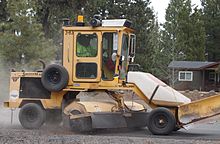Grader
This article needs additional citations for verification. (March 2012) |


A grader, also commonly referred to as a road grader, a blade, a maintainer, or a motor grader, is a construction machine with a long blade used to create a flat surface. Typical models have three axles, with the engine and cab situated above the rear axles at one end of the vehicle and a third axle at the front end of the vehicle, with the blade in between. In certain countries, for example in Finland, almost every grader is equipped with a second blade that is placed in front of the front axle. Some construction personnel refer to the entire machine as "the blade." Capacities range from a blade width of 2.50 to 7.30 m and engines from 93–373 kW (125–500 hp). Certain graders can operate multiple attachments, or be used for separate tasks like underground mining.
In civil engineering, the grader's purpose is to "finish grade" (refine, set precisely) the "rough grading" performed by heavy equipment or engineering vehicles such as scrapers and bulldozers.
Graders are commonly used in the construction and maintenance of dirt roads and gravel roads. In the construction of paved roads they are used to prepare the base course to create a wide flat surface for the asphalt to be placed on. Graders are also used to set native soil foundation pads to finish grade prior to the construction of large buildings.Graders can produce inclined surfaces, to give cant (camber) to roads. In some countries they are used to produce drainage ditches with shallow V-shaped cross-sections on either side of highways.
A more recent innovation is the outfitting of graders with GPS technology, such as manufactured by Topcon Positioning Systems, Inc., Trimble Navigation, Leica Geosystems or Mikrofyn[1] for precise grade control and (potentially) "stakeless" construction.

History
The first self-propelled grader was made by the Russell Grader Manufacturing Company in 1920: the Russell Motor Hi-Way Patrol. Early graders such as this were propelled by separate tractor units, with the grader blade as an attachment. After purchasing the company in 1928 Caterpillar went on to integrate the tractor and grader into one design - at the same time replacing crawler tracks with wheels to yield the first rubber-tyre self-propelled grader, the Caterpillar Auto Patrol, released in 1931.[2]
Regional uses
In some locales such as Northern Europe, Canada, and places in the United States, graders are often used in municipal and residential snow removal. In scrubland and grassland areas of Australia and Africa, graders are often an essential piece of equipment on ranches, large farms, and plantations to make dirt tracks where the absence of rocks and trees means bulldozers are not required.

Manufacturers
- Case Corporation
- Caterpillar Inc.
- Deere & Company
- Galion Iron Works
- Komatsu Limited
- LiuGong Construction Machinery, LLC.
- Mitsubishi Heavy Industries
- New Holland Machine Company
- Sany
- Sinomach
- Volvo Construction Equipment
See also
References
- ^ http://www.mikrofyn.com
- ^ Orlemann, Eric (2007). "The Caterpillar Century" (2nd ed.). Motorbooks International. p. 118. ISBN 978-0-7603-2961-0. Retrieved 7 March 2012.
External links
- A Road-Scraper That Cuts Through Snow, Popular Science monthly, February 1919, page 26, Scanned by Google Books: http://books.google.com/books?id=7igDAAAAMBAJ&pg=PA26
